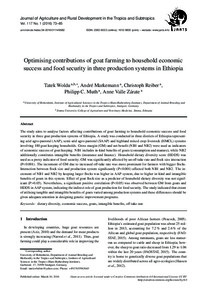Aufsatz

Optimising contributions of goat farming to household economic success and food security in three production systems in Ethiopia
Zusammenfassung
The study aims to analyse factors affecting contributions of goat farming to household economic success and food security in three goat production systems of Ethiopia. A study was conducted in three districts of Ethiopia representing arid agro-pastoral (AAP), semi-arid agro-pastoral (SAAP) and highland mixed crop-livestock (HMCL) systems involving 180 goat keeping households. Gross margin (GM) and net benefit (NB1 and NB2) were used as indicators of economic success of goat keeping. NB1 includes in-kind benefits of goats (consumption and manure), while NB2 additionally constitutes intangible benefits (insurance and finance). Household dietary diversity score (HDDS) was used as a proxy indicator of food security. GM was significantly affected by an off-take rate and flock size interaction (P<0.001). The increment of GM due to increased off-take rate was more prominent for farmers with bigger flocks. Interaction between flock size and production system significantly (P<0.001) affected both NB1 and NB2. The increment of NB1 and NB2 by keeping larger flocks was higher in AAP system, due to higher in-kind and intangible benefits of goats in this system. Effect of goat flock size as a predictor of household dietary diversity was not significant (P>0.05). Nevertheless, a significant positive correlation (P<0.05) was observed between GM from goats and HDDS in AAP system, indicating the indirect role of goat production for food security. The study indicated that extent of utilising tangible and intangible benefits of goats varied among production systems and these differences should be given adequate attention in designing genetic improvement programs.
Zitierform
In: Journal of Agriculture and Rural Development in the Tropics and Subtropics. Kassel : Kassel University Press. - Vol. 117, No. 1 (2016), S. 73-85Sammlung(en)
Vol 117, No 1 (2016) (Journal of Agriculture and Rural Development in the Tropics and Subtropics (JARTS))Zitieren
@article{urn:nbn:de:hebis:34-2016011149582,
author={Woldu, Tatek and Markemann, André and Reiber, Christoph and Muth, Philipp C. and Valle Zárate, Anne},
title={Optimising contributions of goat farming to household economic success and food security in three production systems in Ethiopia},
year={2016}
}
0500 Oax 0501 Text $btxt$2rdacontent 0502 Computermedien $bc$2rdacarrier 1100 2016$n2016 1500 1/eng 2050 ##0##urn:nbn:de:hebis:34-2016011149582 3000 Woldu, Tatek 3010 Markemann, André 3010 Reiber, Christoph 3010 Muth, Philipp C. 3010 Valle Zárate, Anne 4000 Optimising contributions of goat farming to household economic success and food security in three production systems in Ethiopia / Woldu, Tatek 4030 4060 Online-Ressource 4085 ##0##=u http://nbn-resolving.de/urn:nbn:de:hebis:34-2016011149582=x R 4204 \$dAufsatz 4170 7136 ##0##urn:nbn:de:hebis:34-2016011149582
<resource xsi:schemaLocation="http://datacite.org/schema/kernel-2.2 http://schema.datacite.org/meta/kernel-2.2/metadata.xsd"> 2016-04-19T08:50:12Z 2016-04-19T08:50:12Z 2016-03-10 1612-9830 2363-6033 urn:nbn:de:hebis:34-2016011149582 http://hdl.handle.net/123456789/2016011149582 eng Kassel University Press Urheberrechtlich geschützt https://rightsstatements.org/page/InC/1.0/ dietary diversity economic success goats intangible benefits off-take rate 630 Optimising contributions of goat farming to household economic success and food security in three production systems in Ethiopia Aufsatz The study aims to analyse factors affecting contributions of goat farming to household economic success and food security in three goat production systems of Ethiopia. A study was conducted in three districts of Ethiopia representing arid agro-pastoral (AAP), semi-arid agro-pastoral (SAAP) and highland mixed crop-livestock (HMCL) systems involving 180 goat keeping households. Gross margin (GM) and net benefit (NB1 and NB2) were used as indicators of economic success of goat keeping. NB1 includes in-kind benefits of goats (consumption and manure), while NB2 additionally constitutes intangible benefits (insurance and finance). Household dietary diversity score (HDDS) was used as a proxy indicator of food security. GM was significantly affected by an off-take rate and flock size interaction (P<0.001). The increment of GM due to increased off-take rate was more prominent for farmers with bigger flocks. Interaction between flock size and production system significantly (P<0.001) affected both NB1 and NB2. The increment of NB1 and NB2 by keeping larger flocks was higher in AAP system, due to higher in-kind and intangible benefits of goats in this system. Effect of goat flock size as a predictor of household dietary diversity was not significant (P>0.05). Nevertheless, a significant positive correlation (P<0.05) was observed between GM from goats and HDDS in AAP system, indicating the indirect role of goat production for food security. The study indicated that extent of utilising tangible and intangible benefits of goats varied among production systems and these differences should be given adequate attention in designing genetic improvement programs. open access In: Journal of Agriculture and Rural Development in the Tropics and Subtropics. Kassel : Kassel University Press. - Vol. 117, No. 1 (2016), S. 73-85 Woldu, Tatek Markemann, André Reiber, Christoph Muth, Philipp C. Valle Zárate, Anne Gedruckte Ausg. im Verlag Kassel Univ. Press (www.upress.uni-kassel.de) erschienen. </resource>
Die folgenden Lizenzbestimmungen sind mit dieser Ressource verbunden:
Urheberrechtlich geschützt

